May 13, 1943
I won’t talk about us now. We have all been anxious about our friends who were lost at sea. Among them are names that are so dear to me that I am afraid to utter them. I can’t write you about everything. You may have heard of what happened to D.B. from Maoz, A. from Ashdot, M.Z. from Naan, P. from Degania Beit and others. They should have joined us but… However, we don’t know the exact number of the losses and who was saved. Perhaps you can write me about this.
Moshe Mosenson
Letters From the Desert (p. 190)
(Translated by Hilda Auerbach)
Sharon Books, Inc., 1945
In late 1983, I spent an afternoon at the Mount Herzl Military Cemetery in Jerusalem, Israel.
As I walked among the graves, I was struck by a feeling that remains indelible, even today: An overwhelming sense of recency. Recency, from the manner in which at so many graves, flowers, memorial candles, military insignia, and photographs – of soldiers in childhood, adolescence, and adulthood – had been carefully placed. The graves were obviously places of visits and commemoration, in very contemporary, very real, “time”. A few headstones were flanked with casings of expended artillery shells from which, evidently elaborately, portions of the casing had been removed, leaving behind ornate silhouettes of military emblems. Standing upright, no longer weapons of war, the casings by now served as planters for gently drooping pillars of greenery that shaded and framed these matzevot.
And then, the people. Or, more accurately, the women. I still remember being approached by a woman – in her 50s? her 60s? – and being asked a question, in Hebrew. I could not understand her, which I think she rapidly realized from my silence. We stood there, facing one another. Then, she smiled at me for a moment in a sincere, ironic, and gentle way. As she walked away, I approached the gravesite she had just visited.
There, the plants decorating the mazteva had just been watered.
I walked further. I came to the memorial for the crew of the submarine Dakar, recognizable from its stylized stone tower – representing a conning tower – projecting upwards through an elongated, faceted, smooth base. Walking into the memorial, I was struck by the simplicity of the design. Each crewman was commemorated by a stone plaque mounted within the interior walls, the primary illumination coming from sunlight shining downwards along the exterior of the “tower”.
I came to another monument, but the nature of the event it commemorated was unknown to me. A blue-tiled, shallow, rectangular pool (dry during my visit) formed its center, and was surrounded by black, rectangular tiles – each tile bearing a single name, and, a two-digit number indicating the age of the man it commemorated. A stone tower at a corner of the pool which seemed to connote the bridge of a naval vessel. Upon its upper part was a phrase in Hebrew (with vowels associated with the letters – how unusual for an Israeli monument!), with its incised letters in made more obvious by having been painted in yellow.
I realized that this structure commemorated some kind of naval event in which many lives had been lost. But, where? But, when?
I knew of no event which involved the loss of so many Jewish servicemen, in a nautical setting, in contemporary times. Obviously, this event, regardless of when it had occurred, left a deep impact upon the collective memory of the Yishuv, remaining strongly enough in the consciousness of the re-established Jewish nation state to merit the creation of such a monument.
* * * * * * * * * *
In the late 1990s, I discovered the website of Britain’s Commonwealth War Graves Commission (CWGC), which is easily – in terms of design, use, capability, and scope – one of the premier websites extant in the arenas of military / genealogical / historical research. (The only real equivalents in terms of ease of use and capability are the Russian Federation’s OBD Memorial database, and, the websites of the National Archives of Australia and Australian War Memorial.)
In 2000 I acquired a copy of the book We Will Remember Them: A Record of Jews Who Died in the Armed Forces of the Crown, 1939-1945, by Henry Morris, a member of AJEX, the Association of Jewish Ex-Servicemen and Women. I then began using the CWGC database to retrieve records for every name listed in the book’s 289 pages.
Then, I noticed something.
As I searched for records for Jewish soldiers from the Yishuv (“The Palestine Jewish Volunteers”) who died in WW II, a consistent trio of data elements (date, military unit, and place of commemoration: “May 1, 1943”, “462nd General Transport Company”, and “Brookwood Memorial” (at Surrey, England) were returned with an odd and telling frequency. As I progressed through the list of names, records comprising these three parts grew in number, reaching ten, then fifty, then one hundred; and finally more. It became obvious that the common thread linking these names was a major incident; a disaster of some sort, at sea, somewhere in the European or Mediterranean Theaters of War. But, what was that incident?
Not long afterwards, the answer again came from the fine work of Henry Morris. A supplementary volume of We Will Remember Them was published in 1994, and within, Mr. Morris presented the story behind the loss of these men in the Spring of 1943. Rather than summarize or recapitulate his fine account, I shall present it here, with appreciation for and acknowledgement of his research.
Herewith:
A DIFFERENT MAY DAY
There it was again: “Killed in action at sea, 1st May 1943”. I was checking the print-out for the Roll of Honour in my book, We Will Remember Them, and, again and again, this entry followed the names of men killed while serving with the Royal Army Service Corps of the Palestine Regiment. I counted them. There were 148, all killed on the same day – the greatest loss suffered by the Palestine Jews who fought and served with the British Army. “How did this happen?” I asked myself, and I learned the answer with the help of the Israel Ministry of Defence, the RASC Regimental Museum in England, records held by Israel military historians, the Israel War Veterans League and survivors of the tragedy who subsequently settled in the USA
462 Coy RASC had been part of the forces surrounded by the German Africa Korps in the siege of Tobruk and had then taken part in the battle of El Alamein. In his book, Soldiers from Judea, Rabbi Rabinowitz, Senior Jewish Chaplain MEF, writes: “In the victorious advance of General Montgomery five RASC units took part. 462 GT Coy commanded by Major H. Yoffe, a South African Jew, 178 Coy commanded by Maj. Wellesley Aron, a British Jew, 11 Water Tank eventually commanded by Maj. B. Adelman, a Canadian Jew, 5 WT commanded by Maj Y. Frumkin and 179 GT, commanded by Maj I. Boganov”. After performing heroically throughout the North African campaign, in April 1943, three weeks before the fall of Tunis, 178 and 462 Companies were informed that they had been chosen for “highly operational work of the first importance”. One hundred and seventy-eight went to Tripoli and 462 went to Alexandria. It was intended that they should go on to Malta where “the George Cross Island was to be changed from a battered place of siege to a base of attack”. But it was not to be – the flower of Palestine Jewish youth was to perish in less than five minutes.
During February and March of 1943, together with other Jewish forces, they were in Bengazi. In April they were sent to Egypt. There, in Tahay Camp, they organised for a new mission while enjoying the Passover holiday. After two weeks they transferred to Ameria Camp in Alexandria and awaited their departure. On 29th April, they sailed on the 5,000 ton World War One Indian Merchant ship, the Erinpura. She was the flagship of a convoy of twenty seven excluding escort. On board were 334 officers and men of 462 Coy and 700 Basuto soldiers from Africa. On Friday evening, 30th April, the Commanding Officer, Maj. Yoffe, informed his men that they were on their way to Malta.
From information received from survivors and the official report submitted by Maj. Yoffe, I was able to piece together the story of what happened on that fateful night.
On the evening of the 1st May the convoy was approached by an enemy aircraft. Here I have varying reports of what followed. One claims that it was Italian and was driven off by anti-aircraft gunfire, another says it was a Heinkel that dropped a torpedo that failed to hit and was shot down. There is a third version saying it was an unidentified German plane that flew too low for the guns to attack. Such is the confusion of an air raid at sea. The official report writes that, following this opening move, “In accordance with Ship’s Standing Orders, Action Stations” had been ordered. All men without duties had been ordered below deck.
At about 20.10 hrs. [8:10 P.M.] on 1st May 1943 there was an attack by enemy aircraft and, although bombs were dropped, the ship was not affected. About 20.50 [8:50 P.M.] there was a second aircraft attack. It was a very heavy raid and many bombs were dropping all around. At 21.05 [9:05] Maj. Yoffe was at his command position on the saloon deck, where he was immediately available and could employ maximum control, when a terrific explosion occurred forward of the bridge and he was knocked over by an enormous wave. When he recovered, the ship was going down at the bows. Orders came from the bridge to abandon ship. Attempts were made by officers to get the men up from below – many may have been dead already, but all ladders and gangways had been smashed by the explosion. A large number of men were still below when the bows were completely under water, within two minutes of the explosion. The ship was listing badly, making it impossible to lower boats. Of the two that succeeded, one capsized. Every raft and anything that floated had been thrown overboard and the men were ordered to jump. Taking all the circumstances into consideration Maj. Yoffe gave the opinion that everything possible had been done to evacuate the ship.
The light was failing when the ship went down and the convoy was out of sight of land. By the time the men had been in the water for ten minutes it was completely dark. The ship sank in about four minutes. It was not certain whether it had been struck by a torpedo or an aerial mine. One survivor told me he was in the water for several hours before being picked up, as the convoy was not allowed to search and rescue. He relates that the Basuto soldiers in the water added their voices in song to the Hebrew songs being sung by the Jewish soldiers.
Another survivor wrote that he spent all night clinging to a piece of wood and was picked up by a Greek destroyer. The Captain and the soldiers manning the guns were the last to jump. The attack continued and there are reports of the men in the water being machine gunned. Sgt. Bijovsky, a survivor, reports: “The rescue was very difficult, many of us did not know how to swim, it was dark, they did not manage to get down the lifeboats, the cries of the drowning were terrible. Our commander, Maj. Yoffe, was all the time with us, he did not leave his soldiers, he could be proud of our behaviour”. The British and Greek sailors from the rescue ships did all they could to save the men in the water.
The survivors were taken by the British minesweeper Santa to the port of Bengazi and by the Greek warship Adrias to Tripoli, others went to Malta.
One hundred and forty-eight soldiers of 462 Coy died in the disaster, many others were wounded and hospitalised. After a period of recovery they were transferred to Egypt and, eventually, to live in Eretz Israel.
In July and August of 1943 the RASC unit commanded by Lt./Col. Charkham OBE was reinforced by the survivors of 462. This unit was undergoing training for the D-Day landing on Pestume Beach, Salerno. The reconstituted 462 Coy, led by Maj. Yoffe, also took part in the landings and subsequently assisted at the beach head, Anzio, until the final breakout where they suffered casualties in men and equipment. As part of the 8th Army in Italy they had returned as liberators to the continent which many had left as hunted and despised refugees, veterans of the desert, sons of Jewry in whom we take great pride.
At the Military Cemetery on Mt Herzl in Jerusalem there is a monument in the form of a ship inscribed with the names of those brave men who died on 1st May 1943.
HM
We Will Remember Them – A Record of the Jews Who Died in the Armed Forces of the Crown, 1939-1935, An Addendum
Written and Compiled by Henry Morris
Edited by Hilary Halter
Published by AJEX, 1994
Thus, the story which forms the basis of and inspiration for this – and subsequent – posts.
* * * * * * * * * *
Images of the S.S. Erinpura, and, the memorial and monument to the men of the 462nd General Transport Company at Mount Herzl Cemetery, appear below.
* * * * * * * * * *
 This image, found at the excellent Naval Warfare website, shows the S.S. Erinpura as she appeared while in service with the British India Steam Navigation Company. Naval Warfare presents a substantive history of the ship, and, a solidly moving summary of the story of her 1943 sinking.
This image, found at the excellent Naval Warfare website, shows the S.S. Erinpura as she appeared while in service with the British India Steam Navigation Company. Naval Warfare presents a substantive history of the ship, and, a solidly moving summary of the story of her 1943 sinking.
* * * * * * * * * *
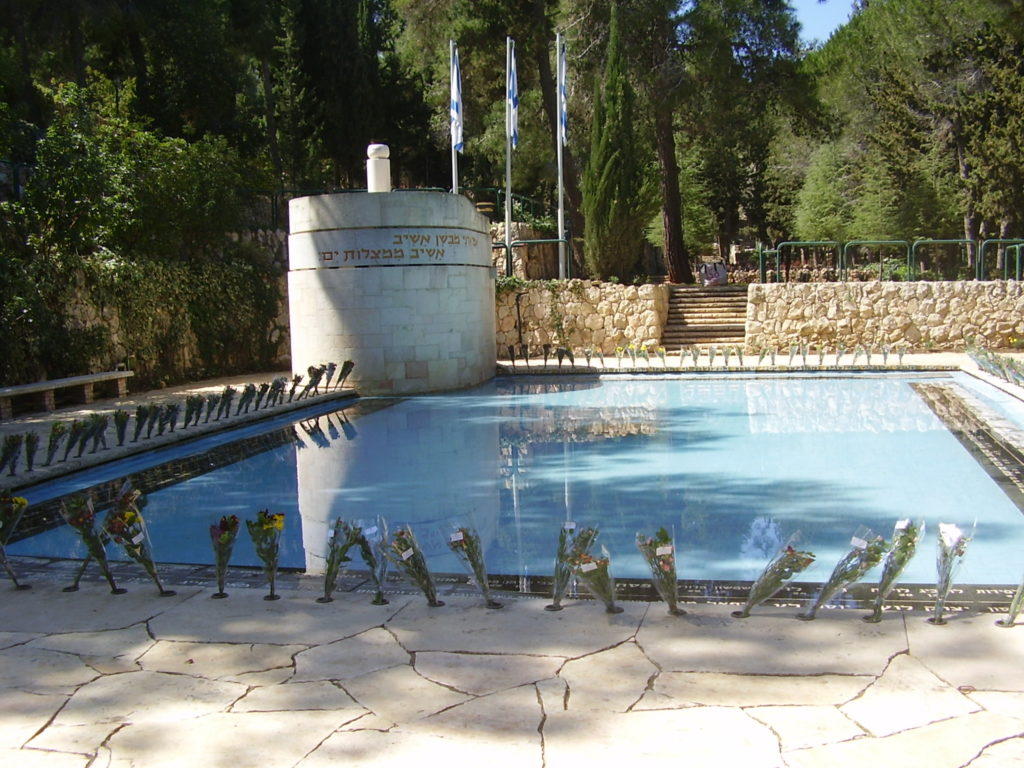 An image of the Erinpura Memorial taken by Avishai Teicher, via Wikimedia Commons. As described by Azaryahu Maoz and Menashe Shani in their book In Death They Commanded – The Architecture of Military Cemeteries in Israel, the Early Years, the monument, designed by architect Asher Hiram, was unveiled on April 29, 1954.
An image of the Erinpura Memorial taken by Avishai Teicher, via Wikimedia Commons. As described by Azaryahu Maoz and Menashe Shani in their book In Death They Commanded – The Architecture of Military Cemeteries in Israel, the Early Years, the monument, designed by architect Asher Hiram, was unveiled on April 29, 1954.
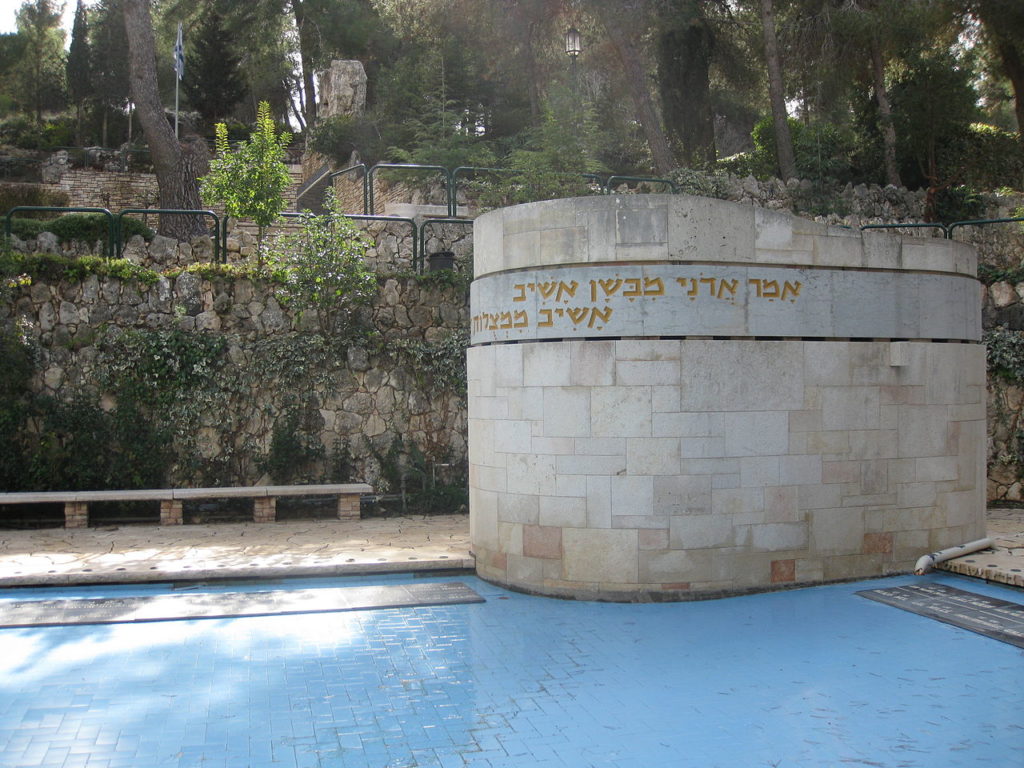 A symbolic ship’s bridge, with Verse 23 from Psalm 68 (“I will retrieve them from Bashan, I will retrieve them from the depths of the sea.”) set apart from the main edifice as separate row of stones. A Wikimedia Commons image taken by Avi Deror.
A symbolic ship’s bridge, with Verse 23 from Psalm 68 (“I will retrieve them from Bashan, I will retrieve them from the depths of the sea.”) set apart from the main edifice as separate row of stones. A Wikimedia Commons image taken by Avi Deror.
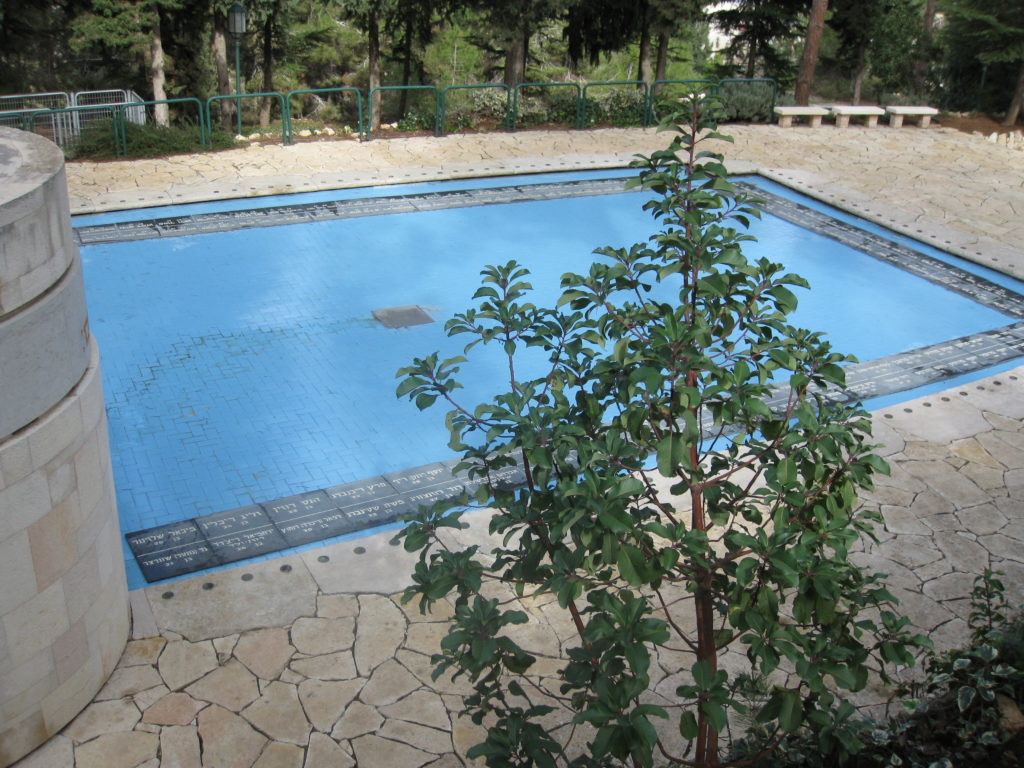 The Erinpura Memorial viewed from behind the “ship’s bridge”. Another Wikimedia Commons image by Avi Deror.
The Erinpura Memorial viewed from behind the “ship’s bridge”. Another Wikimedia Commons image by Avi Deror.
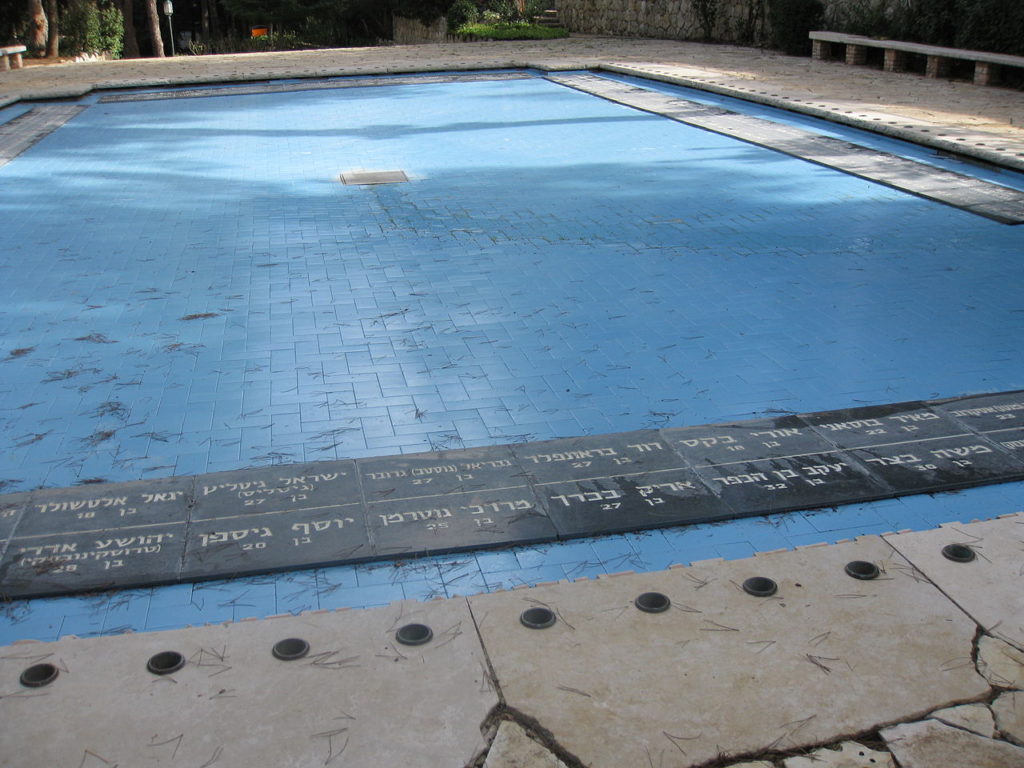 Another view of the Erinpura Memorial. In this image, the memorial has apparently been drained of water, and more clearly shows the individual tiles bearing soldiers’ names and ages. This image is also by Avi Deror.
Another view of the Erinpura Memorial. In this image, the memorial has apparently been drained of water, and more clearly shows the individual tiles bearing soldiers’ names and ages. This image is also by Avi Deror.
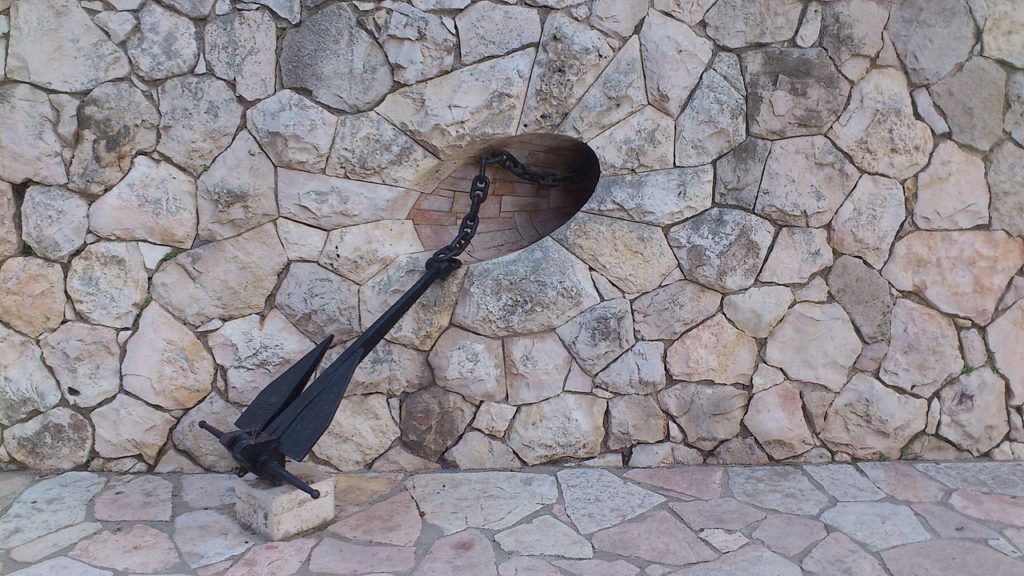 This Wikimedia Commons image shows an anchor; an appropriate nautical symbol at the Erinpura Memorial.
This Wikimedia Commons image shows an anchor; an appropriate nautical symbol at the Erinpura Memorial.
 Another image from Wikimedia Commons image, showing a map of the Mount Herzl Cemetery. The Erinpura Memorial is denoted by the very small reddish-brown rectangle in the center of the cemetery, listed on the map as locality “4”.
Another image from Wikimedia Commons image, showing a map of the Mount Herzl Cemetery. The Erinpura Memorial is denoted by the very small reddish-brown rectangle in the center of the cemetery, listed on the map as locality “4”.
* * * * * * * * * *
More will follow.
